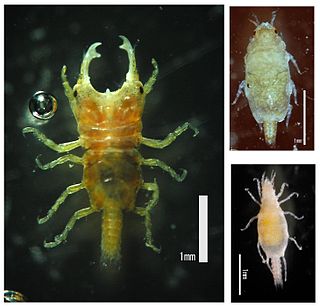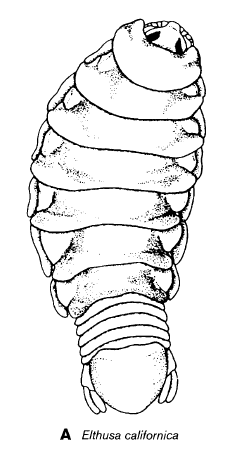
Isopoda is an order of crustacean, which includes woodlice and their relatives. Members of this group are called Isopods and include both terrestrial and aquatic species. All have rigid, segmented exoskeletons, two pairs of antennae, seven pairs of jointed limbs on the thorax, and five pairs of branching appendages on the abdomen that are used in respiration. Females brood their young in a pouch under their thorax.

The Gnathiidae are a family of isopod crustaceans. They occur in a wide range of depths, from the littoral zone to the deep sea. The adults are associated with sponges and may not feed. The juvenile form is known as a 'praniza', and it is a temporary parasite of marine fish. These forms are not larvae; Gnathiidae instead become parasitic during the manca stage. Mancae of the Gnathiidae closely resemble the adult form, however they lack the final pair of pereiopods.

Cymothoa exigua, or the tongue-eating louse, is a parasitic isopod of the family Cymothoidae. It enters fish through the gills. The female attaches to the tongue, while the male attaches to the gill arches beneath and behind the female. Females are 8–29 mm (0.3–1.1 in) long and 4–14 mm (0.16–0.55 in) wide. Males are about 7.5–15 mm (0.3–0.6 in) long and 3–7 mm (0.12–0.28 in) wide. The parasite severs the blood vessels in the fish's tongue, causing the tongue to fall off. It then attaches itself to the remaining stub of tongue and the parasite itself effectively serves as the fish's new "tongue".

Cymothoida is the name of a suborder of isopod crustaceans with a mostly carnivorous or parasitic lifestyle. It contains more than 2,700 described species in four superfamilies. Members of the suborder are characterised by their specialised mouthparts which include a mandible with a tooth-like process which is adapted for cutting or slicing.

Cymothoa is a genus of parasitic isopod crustaceans, containing the species listed below. Not all Cymothoa species are considered parasitic. Some climb onto fish in an act known as phoresy.

Aega psora is a species of isopod crustacean that parasitises a number of fish species in the North Atlantic. It is a serious ectoparasite of larger species of fish, particularly when they are injured.

Ancylomenes pedersoni, sometimes known as Pederson's shrimp and Pederson's cleaner shrimp, is a species of cleaner shrimp. It is part of the genus Ancylomenes and was described in 1958 by Fenner A. Chace Jr. as Periclimenes pedersoni. Ancylomenes pedersoni is found in the Caribbean Sea, often associated with a sea anemone, at depths of 1 to 15 metres. They are often found on the reefs off Bermuda.
Cymothoa elegans is a species of parasitic isopod in the genus Cymothoa. It has rarely been recorded, with all records coming from the north coast of Java. They are in the arthropod phylum and can more closely be classified as crustaceans.

The Barrier Reef chromis, also known as the yellowback puller or shining puller, is a species of damselfish in the family Pomacentridae native to the east coast of Australia. It is a small fish with a yellowish-brown dorsal surface separated by a dark stripe from its silvery flanks and underside.
Anilocra pomacentri is a species of marine isopod in the family Cymothoidae. It is found off the coast of eastern Australia and is an external parasite of the yellowback puller, a species of damselfish. The presence of the parasite on a fish causes a significant slowing of the growth rate and an increased mortality.

The sailfin flying fish is a member of the flying fish family (Exocoetidae). As is typical of other members of its family, this species has the ability to jump out of the water and glide on hypertrophied fins in order to evade predators. It is considered a “two-winged” flying fish, meaning that it only has enlarged pectoral fins, as opposed to “four-winged” flying fish, which have both enlarged pectoral and pelvic fins.

Nerocila is a genus of parasitic isopod crustaceans, with 11 species, which have been found parasitizing Indian marine fishes.

Anilocra capensis is a species of parasitic isopod in the family Cymothoidae. It is endemic to southern Africa. The species preferentially attaches itself to the hottentot seabream.

Elthusa californica is a species of isopod in the family Cymothoidae of the order Isopoda. E.californica is a saltwater parasitic isopod. Like many species of the Elthusa genus, E. californica was first placed in within the Liveneca genus, but later underwent taxonomic revisions.

Ceratothoa oestroides is a crustacean isopod, obligate ectoparasite of marine fish that dwells in the buccal cavity. It is the causative agent of various pathologies including tissue damage at the parasitisation site (tongue), growth defects, decrease in mean host weight and size and increases mortalities in farmed and wild fish populations. It has been recorded in six different fish families: Sparidae, Carangidae, Clupeidae, Maenidae, Scorpenidae, and Mugilidae.

Ceratothoais a genus of isopod ectoparasites of teleost fish, first described by James Dwight Dana in 1852. Infection by Ceratothoa can cause anaemia, lesions, growth retardation, emaciation, and mortality in their fish hosts.
Anuropus is a genus of isopods in the suborder Cymothoida. As of 2021, it is the only genus in the family Anuropidae.

Cyclocotyla is a genus of monogenean flatworms first described in 1821. It currently consists of one valid species, Cyclocotyla bellones, with all other former members reassigned to other genera. However, some consider that the genus is currently a taxon inquirendum.

Rocinela is a genus of isopods in the family Aegidae, and was first described in 1818 by William Elford Leach. The type species is Rocinela danmoniensis Leach, 1818.




















